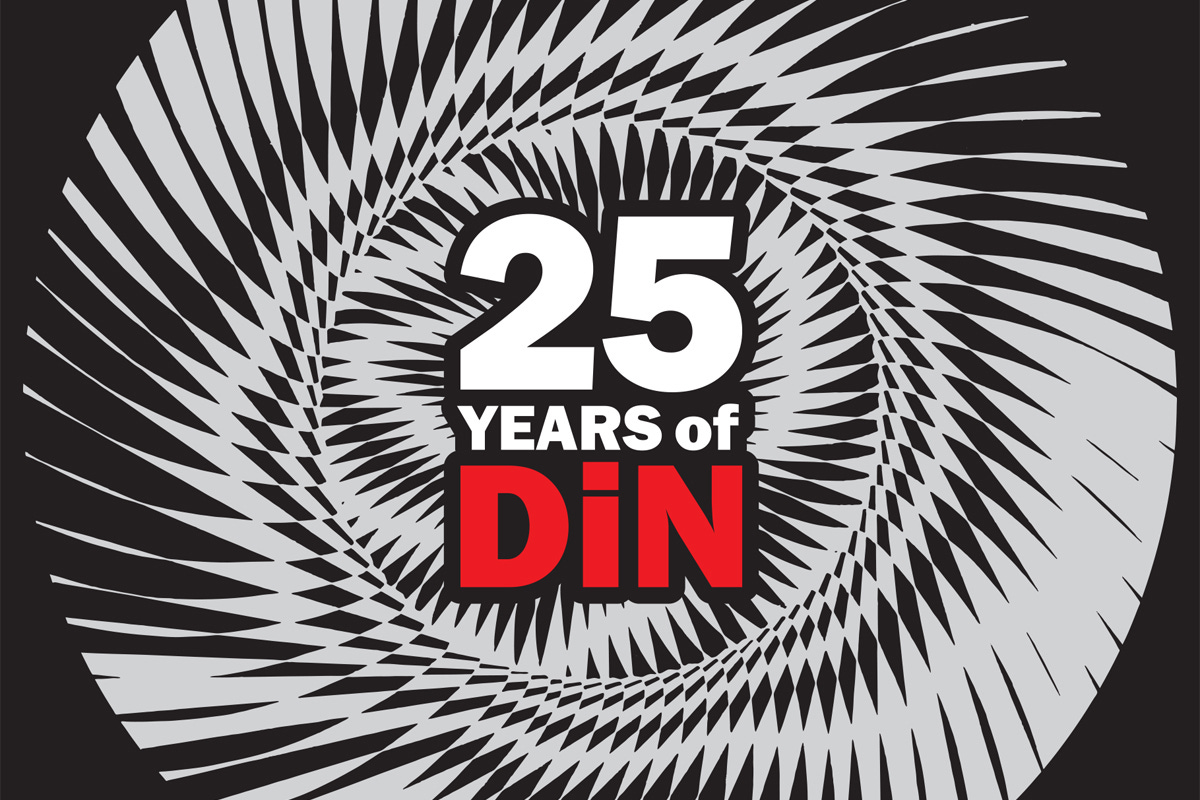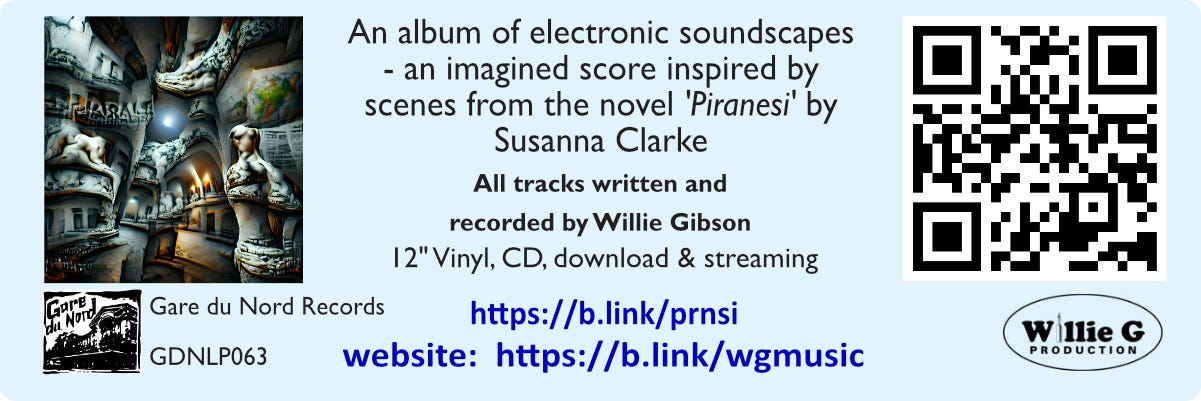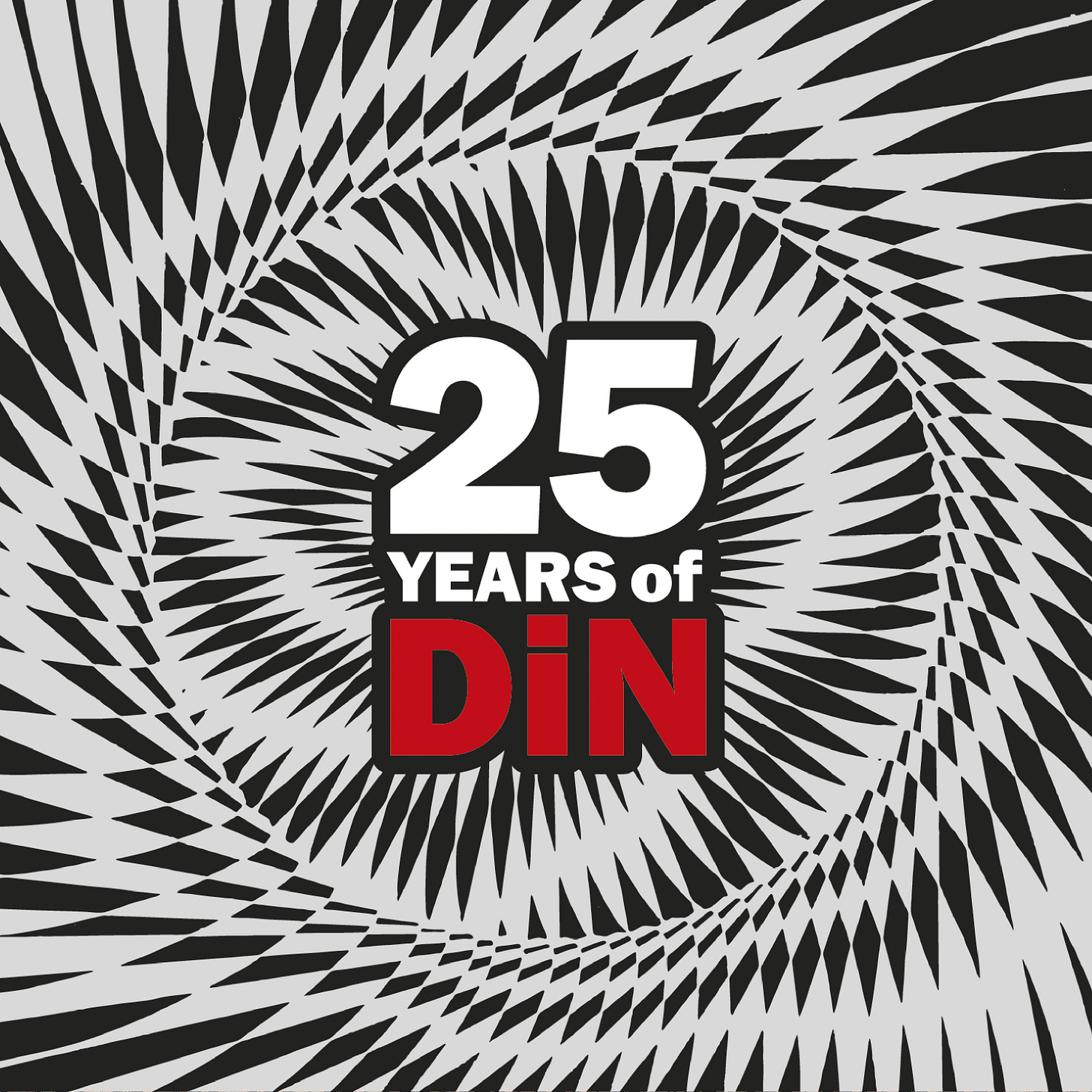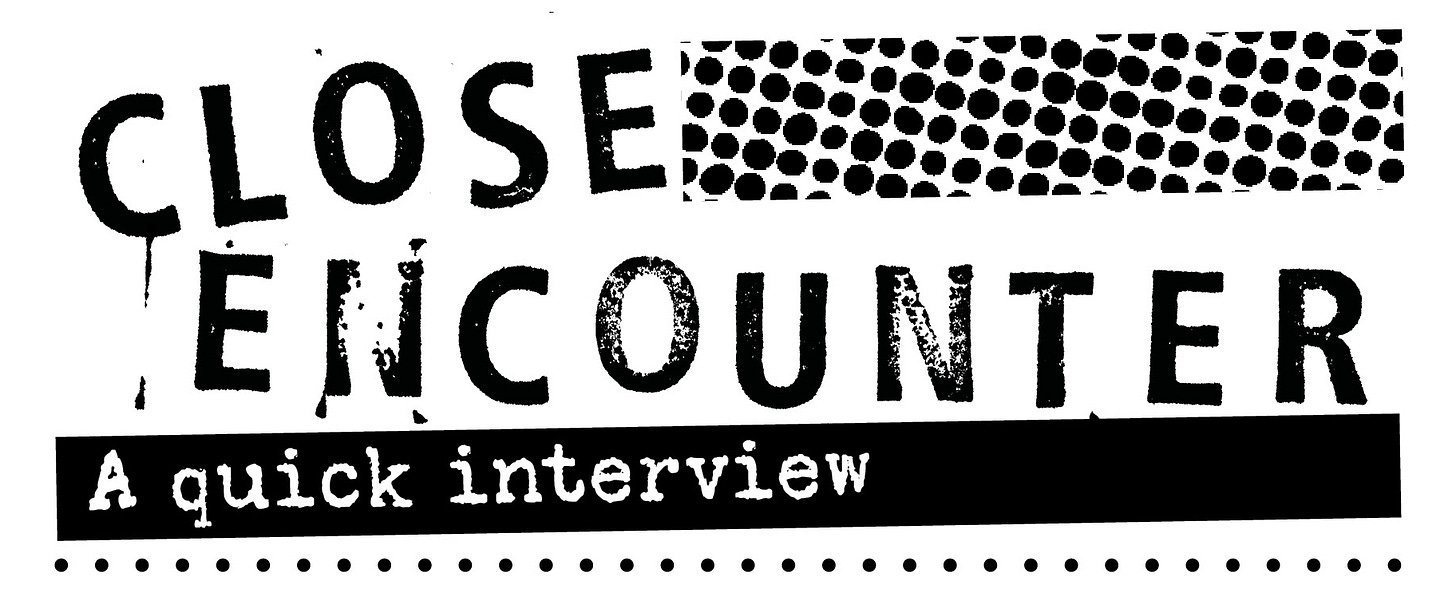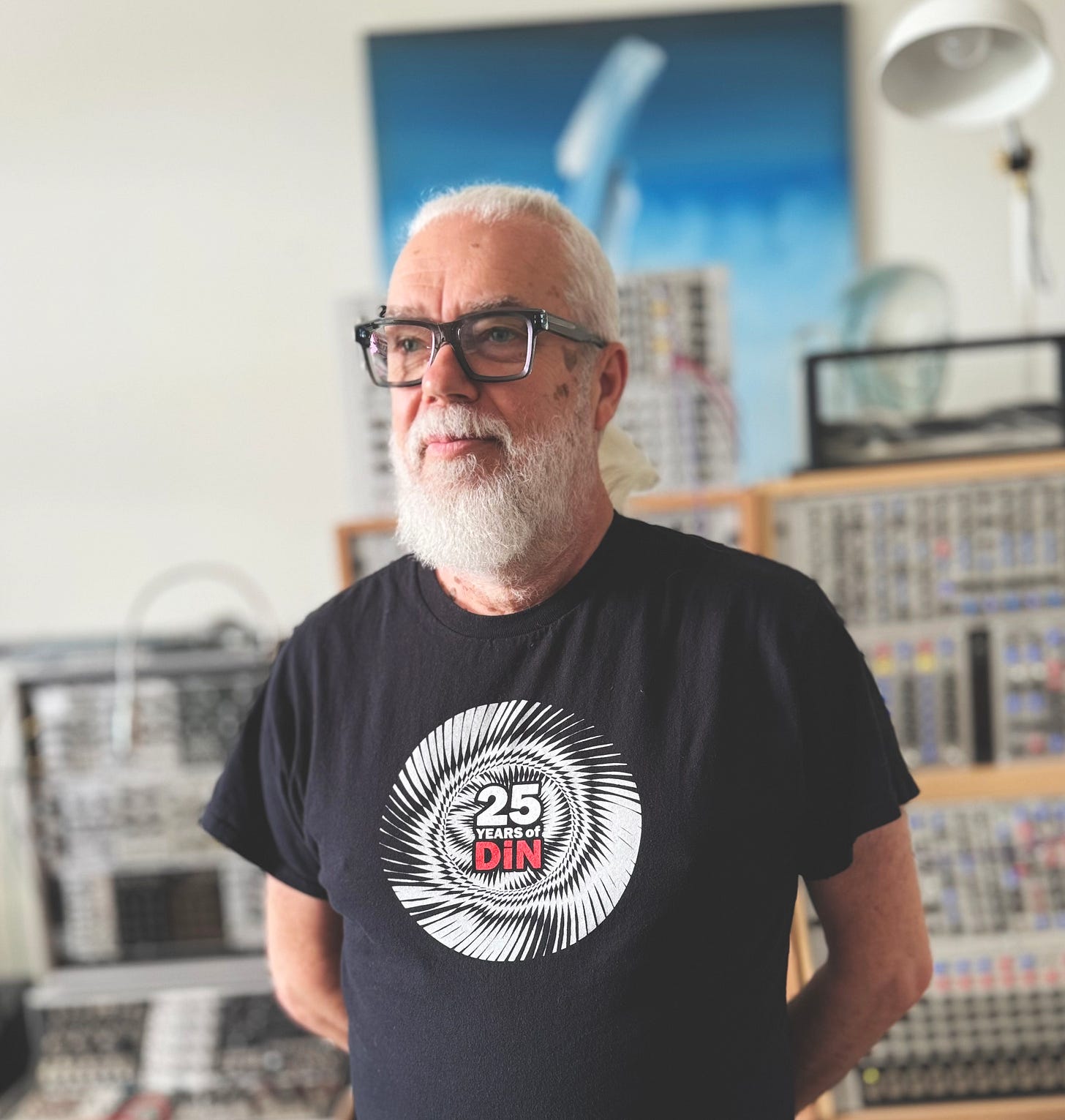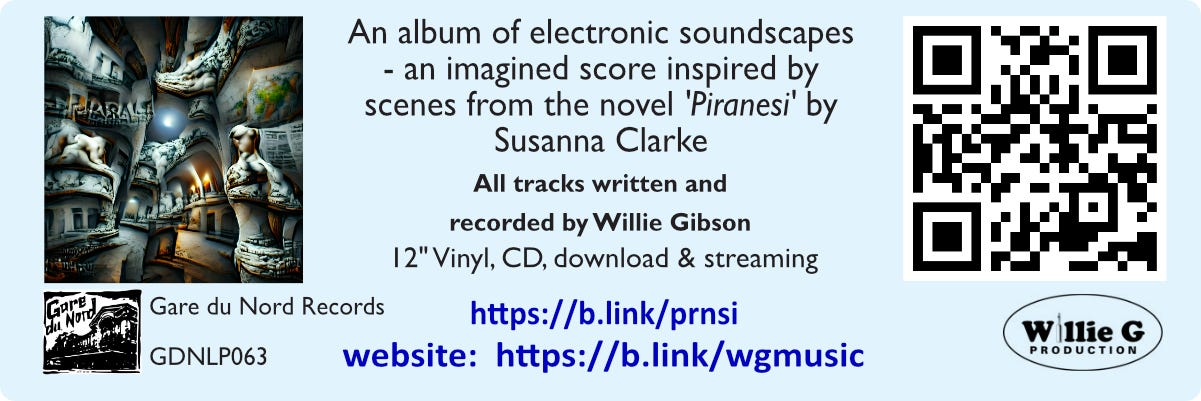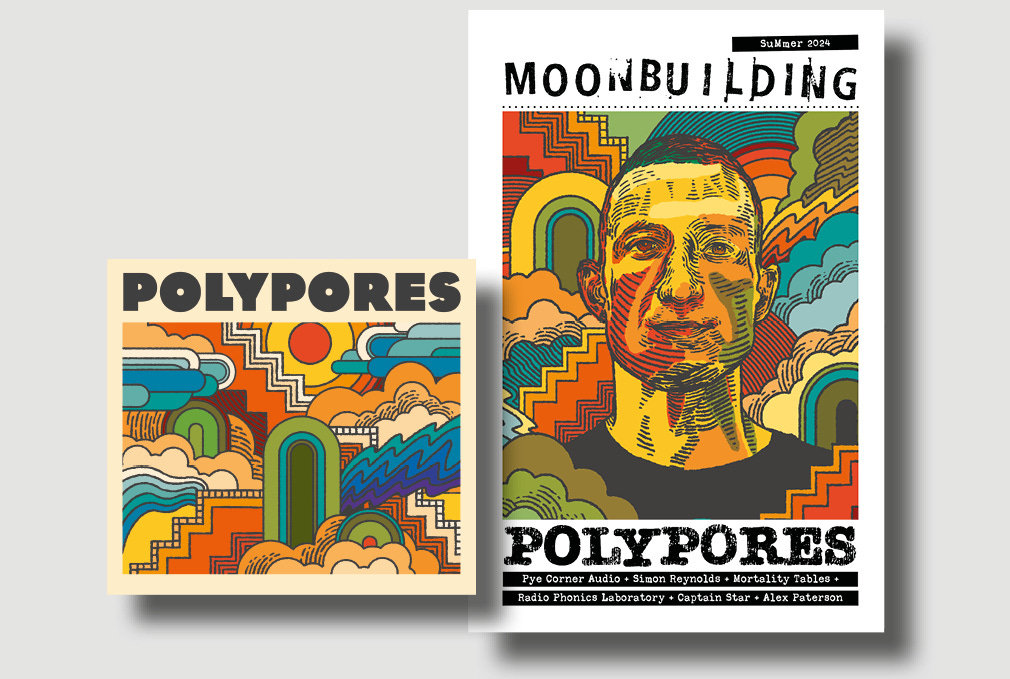Issue 27a / 19 July 2024
In part one of this week's DIY electronic music bulletin... Album Of The Week: '25 Years Of DiN' compilation + Ian Boddy interview + Moonbuilding Issue 5 cover revealed!
You will have noticed that a mere two weeks after saying we’re taking a summer break from the double newsletter Friday, here we are with a double newsletter Friday. We couldn’t miss out on celebrating DiN’s 25th anniversary could we? There might be a couple more double newsletter Friday’s before the summer is out.
In other news, Issue 5 of Moonbuilding is back from the printers and looking very pretty indeed. There’s full details at the bottom of this newsletter, complete with the grand reveal of the cover, which we’ve saved just for you.
The issue will be on sale next Friday, 26 July, from our Bandcamp page at moonbuilding.bandcamp.com. This new issue is going to shift fast as it comes with a brand-new album from our cover star. Yup, you read that right. Scroll down for all the details.
We’ll see you again at 3.30pm for our usual recommender issue full of the best of the latest releases. Happy reading.
Neil Mason, editor
moonbuildingmag@gmail.com
Issue 27 Playlist: See this afternoon’s mailout
The Moonbuilding tip jar: ko-fi.com/moonbuilding
*** This newsletter is sponsored by DiN Records – for more, visit dinrecords.bandcamp.com ***
For sponsorship details, email moonbuildingmag@gmail.com
***ADVERTISE HERE***
Email moonbuildingmag@gmail.com
VARIOUS ARTISTS ‘25 Years Of DiN’ (DiN)
Marking 25 years at the coalface of anything is quite an achievement, keeping a record label going for that long deserves a very big round of applause. It’s probably worth a standing ovation when the label in question is a fully independent, totally DIY kitchen table outfit. Sustaining that kind of thing makes a 25th anniversary a herculean achievement. Just ask Ian Boddy. What he’s achieved with his Sunderland-based DiN label over the last quarter of a century is something special.
While he’s been making music since the 70s and had seen his work released on a smattering of labels, he wanted a more structured way of getting his music out there. “There really wasn’t a label out there catering for the type of music I created so I thought why not set up my own,” he tells me in our chat below about the origins of DiN.
Importantly, he knew how he wanted his music to be received, right down to how it was presented visually, and he knew there were other artist who would appreciate the like-minded thinking. Ian saw that having his own label would allow him to expand his own musical horizons and collaborate with a wider range of musicians. “These musical conversations always lead to interesting places you would not have explored on your own,” he says. And so DiN was born.
From modular supergroup NODE, to duos such as D’Voxx to artists that include Nigel Mullaney, Dave Bessell, Erik Wøllo , Scanner and Chris Carter, the line up of artists who have appeared either solo or by collaboration on the label is impressive. The output is impeccable.
The label is driven by Ian’s singular vision, his own influence is unashamedly Berlin School and it’s in the warm, atmospheric textures drawn from the likes of Tangerine Dream, Klaus Schulze and Manuel Göttsching that you start to see the appeal and understand the success of the label. But there’s more to DiN than high-quality long-form ambient adventures.
The championing of the modular side of life is hugely important and has come into sharp focus in recent years. The ‘Tone Science’ compilation series, now spanning nine volumes, not only shows the breadth and depth of modular music being made today, but it zoomed in on contemporary artists making waves, with Ian placing new names alongside established old hands to present invaluable snapshots of the current modular scene.
Which brings us to ‘25 Years Of DiN’. A double-disced celebration, it isn’t perhaps what you might expect. Most labels would no doubt look at a proper blast from archives to mark the occasion, a collection that revisits their output over the years. Not DiN. While it is a compilation featuring many of the artists who have appeared on the label over the years, here they offer up brand-new tracks.
As you would expect from DiN, it’s a fine collection with plenty of standouts. Benge’s ‘Shadow – The Rest Of Light’ is a great opener, a slow unfurl of a track that builds at a satisfyingly glacial pace before revealing a beautiful, pastoral melody. Node’s Dave Bessell bubbles away on ‘All Is Now’, a track alive with arpeggios and almost classical harmonies, while Evan Bartholomew’s Bluetech serves up a powerful thrum of a meditation that plays with modulation like “light is refracting to create geometric patterns on a wall”.
And that’s just the first three tracks. We’d be here all day if I carry on like this. Needless to say I probably could. Closing the first CD, Polypores ‘Viridescence’ is a proper showstopper. All tip-toey tinkles to start with, the track blooms like a flower over seven minutes plus. It’s the sort of offering that leaves you sat in silence for a moment when it finishes just to catch your thoughts. What Stephen James Buckley does with electricity is something else.
There’s a run of three tracks here that feel like they span the full range of DiN’s modular synthesis adventure. It starts with the wonderful Field Lines Cartographer and the gentle blips and crackles of ‘Sea Of Grass’ conjuring up his exotic far away worlds. It’s followed by Scanner’s ‘Now There Was Nowhere’ that mixes piano, modular and his trademark live radio dial jumping and finally there’s the dark corners and machine growls of ‘Consonance’ that could only be Chris Carter. You can almost hear the ghost of Carter Tutti’s ‘Coolicon’ trying to wriggle its way out.
There’s also a notable double whammy, over 20 minutes of music, that draws this collection to a close in a fitting manner. Node, the synth supergroup consisting of production legend Flood, producer /composer Ed Buller, classically trained musical maestro Dave Bessell and Hollywood film composer Mel Wesson, serve up ‘Rewind’, a swirling locked-down Berlin School-influenced belter complete with their signature “massive vintage Moog modulars”.
The final bow is left to ARC, a collaboration between the late, great electronic music composer Mark Shreeve and who else but the label’s Ian Boddy. It’s a huge track, full of soaring keyboard lines and dense melodies, and it feels like a fitting end to this most thorough of birthday celebrations.
You’ll find all this and so much more in these two mighty discs. And so DiN round up the first 25 years as I’m sure they intend to go on. Facing forwards, not looking backwards.
‘25 Years Of DiN’ is out now on DiN
For more, visit dinrecords.bandcamp.com
IAN BODDY
Happy birthday to you, happy birthday to you, happy birthday dear DiN, happy birthday to you. As his label marks its 25th anniversary, Ian Boddy blows out the candles and makes a wish… which probably isn’t that he can be the first person to be interviewed by Moonbuilding Weekly twice
Photo: Wendy Gibson Boddy
Interview: Neil Mason
Hello Ian, how’s things? What are you up to today?
”Things are good, although I’m currently in the process of calculating the royalties for all of the 86 musicians who are on the DiN and Tone Science labels. Quite a job that is mind-numbingly tedious, but it has to be done. After that I think I’ll go and vegetate in the garden to unwind.”
Happy birthday to DiN, eh? Are you having a party?
”Well I did recently get married to my partner Wendy, who helps me run DiN, does that count?”
25 years is an impressive milestone, back in 1999 did you think the label would get this far?
”I didn’t think I’d get this far let alone the label so no, not really. At that point I had no idea how successful or otherwise it would be. I just went for it. It certainly grew at a glacial pace in the early years as I was also working full time at Akai and had to effectively run the label in my spare time. But it’s certainly taken off in the last few years and is taking up more and more of my time.”
What’s the secret to DiN’s longevity? Why is it still cutting the mustard?
”I always use this quote from the film ‘Galaxy Quest’ – ‘Never give up, never surrender”. I think I have a singular vision with DiN that is centred on my own musical heritage and tastes and this is something I have stuck to. And that includes the visual aesthetic for the label. I recently had a lovely bit of feedback from someone who said something along the lines of it wasn’t so much a label as a way of thinking, which I was rather pleased about. DiN has its own character and over the years this has reached out to more and more folk who like what they hear.”
In what way do you think the label has evolved and grown over the years?
”I’ve continued to bring in new musicians rather than just sticking to the same roster so in recent times I’ve invited artists such as Polypores and Field Lines Cartographer who are from a newer generation of modular synthesists and may not be so familiar to some of the older listeners. Then of course there is the ‘Tone Science’ series that focuses in on the whole modular synth revolution that has blossomed in the last decade. On the one hand, it’s important to remain consistent in what you do, especially quality wise, but on the other hand you need to keep the music fresh.”
For those who don’t know the label, heaven forbid, can you suggest three tracks they should listen to that would sum up DiN?
”Crikey, that’s a tall order. I guess I should include one of mine, so let’s go for ‘Omicron’ from the album ‘Axiom’, which is a real crowd pleaser with it’s kosmische synth arpeggios. Then let’s look at ‘Opera’ by d’Voxx from their debut album ‘Télégraphe’, which again has instant appeal. In fact, this is the opener so when I first got their demo I was like, ‘Wow, this is cool’, and hurriedly signed them up to the label.
“Now it’s getting difficult, but I’m going to go for the latest DiN release, ‘Portable Reality Generator’ by Field Lines Cartographer and the track ‘Collapsable Mantra’. Apart from the fact it’s an awesome piece of music, I like the fact that FLC’s Mark Burford and I discussed this album ahead of time. I felt DiN would give him the chance to try something a little different, with lengthier tracks. While they reference my own personal musical heritage, they are coming from a newer, different place.”
Let’s rewind to the beginning. DIY labels weren’t the done thing in the 90s, why did you want to start one?
”Indeed, and perhaps I was a little mad, but there really wasn’t a label that was catering for the type of music I created so I thought why not set up my own? I also wanted to expand my horizons musically and part of that was to collaborate with a wider range of musicians. This latter point has always been important to me and these musical conversations always lead to interesting places you would not have explored on your own.”
What was the big idea in the beginning? Is that still the big idea now?
”I never saw it as a ‘big idea’, rather than this is what I want to do so I’m going to do it to the absolute best of my abilities. I never take for granted the hard-earned cash fans spend with us and I think those folk deserve the best quality of music I can provide alongside nice packaging with great artwork.”
Who were your favourite labels? Which ones did you look to for inspiration?
”The one I really will reference is the Fax label run by the sadly departed Pete Namlook. This was a label I listened to a lot during the 90s and in some ways was part of the template I used for DiN – even as far as having a three-letter label name. I almost did an album with Pete in 1996, but life events prevented it.”
Did you have any idea how to run a label? What were the initial challenges?
”Nope, I had no idea, although I had been releasing music since 1980 so I did have some experience and contacts via that process. The biggest challenge was time – trying to balance a full-time job with family life as well as running a label was a challenge indeed. However, in 2002 I was made redundant from Akai and I’ve been fully professional music-wise since then. That gave me more time, although in those early years I also did a lot of library music composition as well as sound design work. These two activities gave me sufficient income that in those early days I could run DiN and release albums without having to worry too much about how financially successful they would be, which is of course quite a luxury.”
The first release was your own ‘Box Of Secrets’ album. How did it go? Well enough for their to be a second release at least?
”Actually I aimed bigger than that, the first three albums, so ‘Box Of Secrets’, ‘Distant Rituals’ with Markus Reuter and ‘Strange Geographie’ by Protogonos were released simultaneously. I told you I was mad. I felt the label needed that initial burst of activity for people to take it more seriously than just one release.”
Promoting releases was a whole different ball game back then – no internet, no Bandcamp, no social media… how did you go about it?
”Well, there was carrier pigeon so… As mentioned before, I already had contacts from my previous, almost 20 years of music with various distributors and radio show hosts dotted around the world so in a way I wasn’t starting absolutely from scratch. And I certainly pestered the living daylights out of all of them to help spread the word. The 10th release, which was the first of the ‘iNDEX’ sampler albums, was a subscriber disc for The Wire magazine. Not cheap to do, but it certainly got the music out to a lot of folk.”
You released on CD as vinyl wasn’t much in demand in 1999 was it? What else has changed about running a label in the last 25 years?
”The biggest change in some ways is how much physical product you can sell. It used to be the norm for me to press 1,000 copies of each title, but in the last five years CD sales have really fallen back. Vinyl has never been a focal point for DiN and while other labels out there do a great job with vinyl editions I’ve never found them easy to sell. The whole Bandcamp thing has obviously helped, which provides an easy-to-use online platform for small and larger artists and labels alike. The internet and social media has really taken off and if you’re not careful you can spend way too much time there. It certainly has its place, but you’ve got to balance up any benefits against the large, sludgy pool of nonsense it can sometimes descend into.”
Let’s talk about the birthday release, ‘25 Years of DiN’. It’s a compilation of new tracks, why not a retrospective?
”Interesting question. I just wanted to keep looking forward and also I’ve done plenty of compilation albums on DiN with each 10th release being a sampler of the previous nine releases. So I approached the majority of the artists on the main label and asked for a new, unreleased piece. The life-blood of any label is the artists and I really wanted to showcase them all with their own unique musical personalities.”
It’s a great collection of artists you’ve gathered around you over the years isn’t it? Any particular favourites?
”That’s like trying to pick your favourite child so I’m not going to.”
Which tracks on the album do you think sum up DiN best?
”All of them would be the trite answer. But again, how do I choose? The whole double album has been carefully curated to produce a total listening experience and it’s this that gives the feeling of what DiN is. I’ve been running it for 25 years and I’m just asking for 142 minutes of your time, which seems like a fair deal to me.”
Always interested in your limited edition numbers. This one is an edition of 555. Why 555?
”Because it’s 111 less than the number of the beast.”
Again, it’s a CD. Not tempted to do a big slab of vinyl for your birthday?
”Well, 142 minutes of music would equal a four-album boxset which, while it would have been lovely, would have been prohibitively expensive. Bernhard Wöstheinrich, the graphic designer I use for the main label, and I spent a lot of time creating what we think is a beautiful gatefold CD Digipak design with bold artwork as well as a nice eight-page booklet to read through. I’ve always believed in the art of the possible and in this case I felt that was the way to go.”
You must be very proud of DiN? What do you think is its biggest achievement?
”To have never given up. To have never surrendered. To just keep going in a world that at times seems to ignore niche, quality, artisan music, or whatever you’d like to call it. And by doing this I’ve created a musical microcosmos that many folk like to inhabit and enjoy. That’s good enough for me.”
If someone was thinking of setting up a label, what advice would you give them?
”Don’t! Ha! Only joking. It’s certainly not easy, but if you are in a position to give it your all creatively without having to worry too much about the financial returns then go for it.”
For more about Ian Boddy and DiN, visit ianboddy.com
***ADVERTISE HERE***
Email moonbuildingmag@gmail.com
A MESSAGE FROM THE MOTHERSHIP
***THE NEW ISSUE OF MOONBUILDING IS OUT 26 JULY***
Bloody hell! Will you look at that? The new issue of MOONBUILDING, Issue 5 for those of you who are counting, is almost here. Yes, we’ve taken our sweet time, but it is very much worth the wait.
On the cover, with another cracking illustration from the untouchable Nick Taylor, is the awesome Polypores. In our free-wheeling chat we get right under the hood of Stephen James Buckley’s musical operation, offer up a listening guide to help you safely navigate his extensive back catalogue and we also have a whole new Polypores album exclusively for you.
Yes, you read that right. We are giving you a freshly minted, not available anywhere else new album called ‘The Album I Would Have Released In An Alternate Universe’, which happens to be the sister recording to his forthcoming Castles In Space album ‘There Are Other Worlds’. Read all about it in the new issue where Stephen talks you though it track by track.
Elsewhere, there’s a profile of our new favourite label Mortality Tables, Pye Corner Audio gets in on the There’s A First Time For Everything act, we round up an absolute mountain of recent releases and serve up our thoughts on the best albums from the last few months, including Loula Yorke and Warrington-Runcorn New Town Development Plan. There’s a column from The Orb’s Alex Paterson, which starts off about Jah Wobble and ends up about Andrew Weatherall, and an all-new installment of the brilliant Captain Star cartoon strip.
We’ve gone book crazy of late and this issue features a shit-tonne of great book reviews (that’s great books, reviewed, rather than the reviews being great, although they are pretty good). There’s a cracking chat with Justin Patrick Moore, the author of ‘The Radio Phonic Laboratory’, and a bonus chinwag with the world’s finest music journalist, Mr Simon Reynolds.
You will be kicking yourself and quite hard if you miss out on this issue. Form an orderly queue, we will be opening the virtual doors at moonbuilding.bandcamp.com on 26 July for your purchasing pleasure. This magazine ain’t going to buy itself.
Moonbuilding Weekly is a Castles In Space publication.
Copyright © 2024 Moonbuilding





